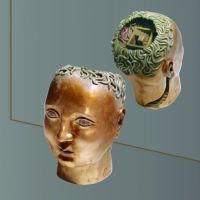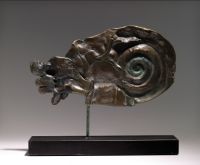Sahra Sak
 1969: born in Alger, Algeria; 1979-1986: secondary school and baccalauréat (sciences) in the Alpes Maritimes, France; 1986-1989: studied architecture in Paris, France; 1989-1993: studied graphic arts in Paris, France; 1993-1995: training in the art of casting with the lost wax method in the Var, France; 1996-2000: lives in San Francisco, USA and works in industrial design; 2000-2001: lives in Guernsey, UK and works in industrial design; 2002: birth of her daughter Zoé; 2001-2009: installation and artistic activities in Finale Ligure, Italy; Exhibitions: • 1994: Cloître des Billettes (Paris IV, France). • 1995: “Les arts dans la rue” (Mougins, France). • 1996: Arts Fair (Antibes, France). • 2001: Personal exhibition (Cannes, France). 2006: • Personal Exhibition (Varigotti, Italy). • Arte Firenze 2006 contemporary arts fair (Florence, Italy). 2007: • Fine Arts Gallery (Heeze, Holland) • Personal exhibition (Verviers, Belgium) • Linéart Fair (Ghent, Belgium) 2008: • Kunst Antiek Weekend (Naarden, Holland) 2009: • Kunst Antiek Weekend (Naarden, Holland) • Exhibition in May at the Mas d’Artigny (Saint Paul de Vence, France) • Continuously at the Art Seiller Gallery in Saint Paul de Vence.
1969: born in Alger, Algeria; 1979-1986: secondary school and baccalauréat (sciences) in the Alpes Maritimes, France; 1986-1989: studied architecture in Paris, France; 1989-1993: studied graphic arts in Paris, France; 1993-1995: training in the art of casting with the lost wax method in the Var, France; 1996-2000: lives in San Francisco, USA and works in industrial design; 2000-2001: lives in Guernsey, UK and works in industrial design; 2002: birth of her daughter Zoé; 2001-2009: installation and artistic activities in Finale Ligure, Italy; Exhibitions: • 1994: Cloître des Billettes (Paris IV, France). • 1995: “Les arts dans la rue” (Mougins, France). • 1996: Arts Fair (Antibes, France). • 2001: Personal exhibition (Cannes, France). 2006: • Personal Exhibition (Varigotti, Italy). • Arte Firenze 2006 contemporary arts fair (Florence, Italy). 2007: • Fine Arts Gallery (Heeze, Holland) • Personal exhibition (Verviers, Belgium) • Linéart Fair (Ghent, Belgium) 2008: • Kunst Antiek Weekend (Naarden, Holland) 2009: • Kunst Antiek Weekend (Naarden, Holland) • Exhibition in May at the Mas d’Artigny (Saint Paul de Vence, France) • Continuously at the Art Seiller Gallery in Saint Paul de Vence.
Collectors cabinet
SAK NAQUNOEIL
SAK BERTHE
SAK ZOE
SAK MUE
SAK MUE
SAK PENSEES
SAK VARIATION SUR Z
SAK MARIAGE
Pauline's comment
Comments by the artist SAK: "I love sculpture in bronze. I started out by sculpting a fantasy and somewhat baroque world, always in relation with the anatomy of the human body. The human being remains, still today, at the origins of all my creations. I want to understand the physical complexities and express them through a more abstract and subjective approach. To start, I create a sculpture in classic fashion and then through the transformation of this piece, by crushing it, stretching it, through the absence or addition of matter, a new sculpture is born: the deconstruction of the objects makes for its rebirth. The initial conception of the classic piece requires a certain rigour, attention and meticulousness that I wish to then liberate thanks to the body language and the spontaneity of movement. On top of that, I like to take into account the role of the random factor in the piece. In effect, all bronze sculptures need a wax copy and it's that wax that I transform and play with: the wax's reaction to the heat as well as the water is a direct participant in these new creations. Finally, with the patina, I begin to discover the notion of colour in bronze sculpture. The colour's freedom highlights and enriches the rigour and technical constraints of the initial creation. My sculptures need time and a slow maturing.” SAK







